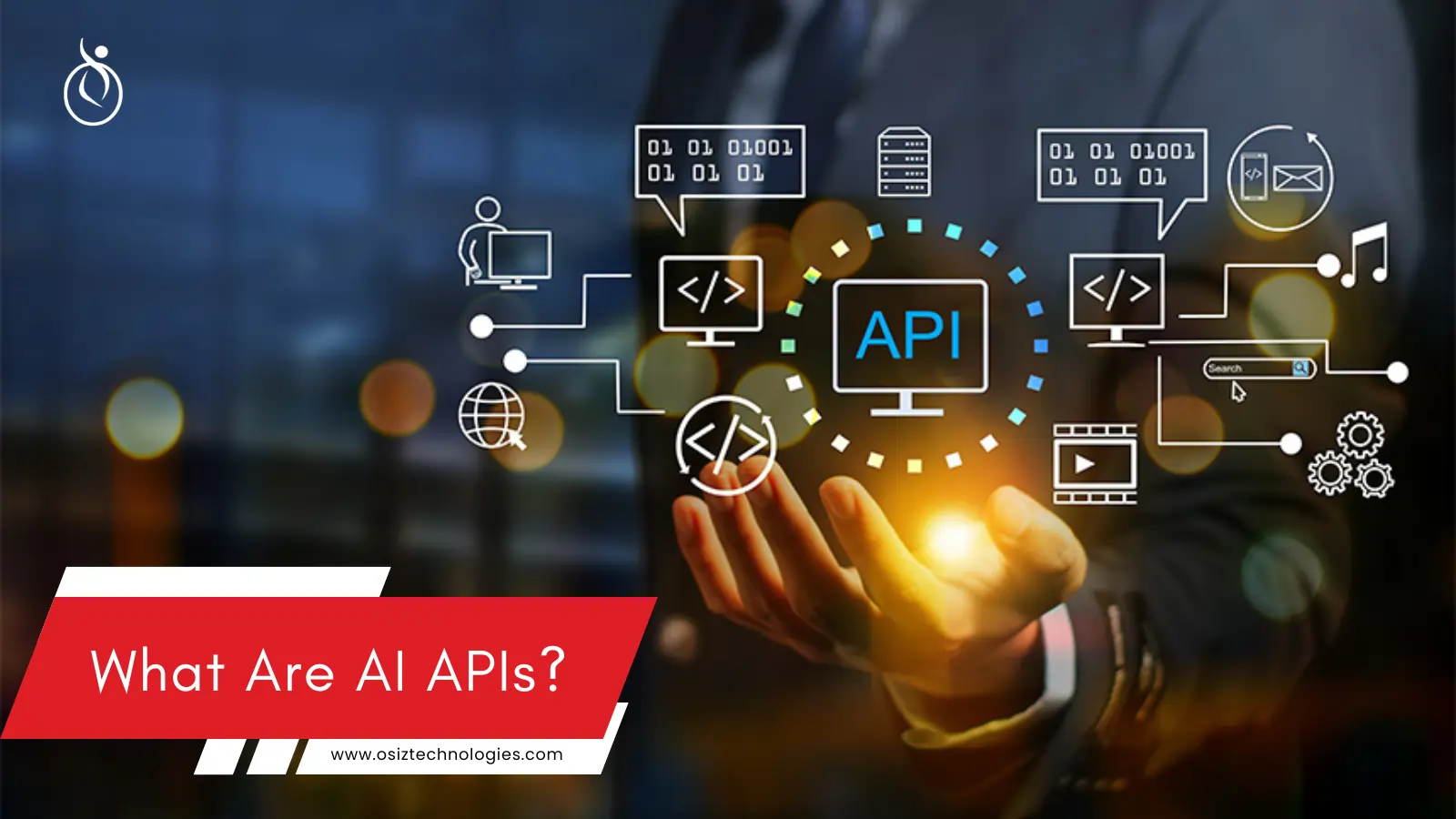AI APIs
AI APIs are simple tools that help developers quickly add advanced AI features to their apps without building everything from scratch. With these APIs, developers can easily leverage advanced AI capabilities like language understanding, image recognition, speech processing, and more with just a few lines of code.
Why AI APIs Matter?
AI APIs are important because they make powerful artificial intelligence accessible, scalable, and easy to implement in applications. They remove the need for organizations to implement complex AI models, which can take a long time for implementation and cost a lot of money, as well as use many development resources. In just a few lines of code, developers can extend applications with features such as speech recognition, image analysis, or natural language comprehension. This reduces the barrier for startups and small businesses who is ready to enter into the market and compete at the same level as established companies. AI APIs increase pace of innovation across different industries - healthcare, finance, retail, and beyond. They support real-time decision-making, automation, and personalization. As AI adoption grows, APIs become the bridge between raw data and smart solutions. They simplify development and accelerate go-to-market timelines.
Types of Artificial Intelligence APIs
Natural Language Processing (NLP) APIs
NLP APIs enable machines to comprehend, interpret, and respond to human language. They power chatbots, sentiment analysis, language translation, and text summarization. Businesses use them to automate customer service and extract insights from text data.
Computer Vision APIs
Computer Vision APIs enable applications to recognize, analyze, and process visual data such as images and video. They are commonly used to detect faces, recognize objects, and perform quality control inspections. Retail, healthcare, and security use them to enable automation and improve accuracy.
Speech Recognition and Text-to-Speech APIs
Speech recognition and text-to-speech APIs convert spoken language to text and text to spoken language. They are major components of virtual assistants, transcription tools, and hands-free applications. They foster hands-free interactions, increase accessibility, and enhance functionality in digital products.
Generative AI APIs
Generative AI APIs create new content like text, images, or code based on input prompts. Tools like ChatGPT and DALL·E use this to generate human-like responses or visuals. Businesses use them for content creation, automation, and innovation.
Predictive Analytics & ML APIs
These APIs analyze historical data to forecast future outcomes and trends. They're essential for recommendation engines, risk assessment, and business intelligence. Companies use them to make smarter, data-driven decisions in real-time.
Benefits of AI APIs
Faster Development
AI APIs let developers integrate powerful features quickly without building models from scratch. This speeds up project timelines and reduces time-to-market.
Cost Efficiency
Using AI APIs eliminates the need for large infrastructure or in-house AI expertise. Businesses save on development and operational costs.
Easy Integration
AI APIs are designed to plug into existing systems with minimal effort. They work seamlessly across apps, platforms, and devices.
Scalability
APIs allow businesses to scale AI capabilities as user demand grows. You can add more functionality without overhauling your system.
Access to Advanced Capabilities
Even without deep AI knowledge, teams can use APIs for NLP, vision, speech, and more. This democratizes access to cutting-edge AI tools.
Improved User Experience
AI-powered features like personalization and instant responses enhance customer satisfaction. APIs help deliver smarter, more intuitive interfaces.
Top AI API Providers in 2025
OpenAI
OpenAI is a leading AI research company known for its powerful APIs like ChatGPT and DALL·E. Their generative AI models enable advanced natural language processing, image generation, and code completion. OpenAI APIs are widely used across industries for automation, content creation, and customer engagement.
Google Cloud AI
Google Cloud AI offers robust APIs such as Vision AI, Natural Language AI, and AutoML. These tools allow developers to integrate image analysis, sentiment detection, and custom model training easily. Known for scalability and enterprise support, Google’s AI stack is popular among tech-driven businesses.
Amazon Web Services (AWS)
AWS provides a wide suite of AI APIs under services like Amazon Rekognition, Polly, and Lex. These cover computer vision, speech synthesis, language understanding, and more. With powerful infrastructure and global reach, AWS is a top choice for enterprise AI deployments.
Microsoft Azure
Microsoft Azure's Cognitive Services deliver APIs for vision, speech, language, and decision-making. Their AI offerings are known for ease of use, cloud-native architecture, and seamless integration with Microsoft tools. Azure is a strong option for businesses seeking flexible and secure AI solutions.
IBM Watson
IBM Watson offers AI APIs focused on natural language understanding, speech-to-text, and machine learning. It is designed for businesses needing deep insights and trustworthy AI solutions. Watson stands out for its enterprise-grade AI with explainability and compliance features.
Stability AI
Stability AI is known for its open-source generative models like Stable Diffusion. It offers APIs for text-to-image generation and creative AI applications. In 2025, Stability AI continues to drive innovation in visual content creation and design automation.
Hugging Face
Hugging Face provides access to thousands of pre-trained models through its Transformers library and Inference API. Developers use it for NLP, translation, summarization, and more. Its open-source approach and active community make it a favorite among AI researchers and builders.
How to Use AI APIs in Your App or Platform?
1. Identify the AI Capability You Need
Start by defining what kind of AI functionality your app requires—such as language translation, image recognition, chat automation, or voice processing. This helps in selecting the most suitable API.
2. Choose a Trusted AI API Provider
Select a provider based on your feature needs, budget, and ease of integration. Popular options include OpenAI (for generative AI), Google Cloud AI (for vision and language), AWS (for robust enterprise tools), and Hugging Face (for open-source models).
3. Sign Up and Get Your API Key
Create an account with the chosen provider, and access the developer dashboard to get your unique API key. This key will authenticate your requests to the AI service.
4. Read the Documentation and SDK Guides
Most AI API providers offer detailed documentation, sample code, and SDKs in multiple programming languages. This makes it easier to understand endpoints, request formats, and response handling.
5. Integrate the API into Your App
Use RESTful API calls or available SDKs to connect the AI functionality to your platform. For example, send a user’s text input to the API and receive a chatbot response in return.
6. Secure and Optimize Your Integration
Always secure your API key and handle user data responsibly. Implement rate limiting, error handling, and caching to ensure smooth performance and scalability.
7. Test and Deploy
Thoroughly test your AI features in different use cases and environments. Once stable, deploy the integrated solution and monitor its performance for continuous improvement.
Future Trends: What’s Next for AI APIs?
AI APIs are rapidly evolving, becoming more powerful, accessible, and industry-specific. In the near future, we’ll see even deeper integration of AI APIs into everyday apps, enabling hyper-personalization and real-time intelligence. Multimodal APIs that combine text, image, and audio processing will dominate across sectors like healthcare, e-commerce, and education. Low-code and no-code platforms will make AI integration easier for non-developers.
Ethical AI and explainable AI APIs will gain traction to build trust and transparency. Edge AI APIs will power intelligent features on devices without relying on cloud processing. APIs for emotional recognition, autonomous decision-making, and 3D content generation are emerging fast. Businesses partnering with a reliable AI Development Company like Osiz can harness these future-ready APIs to stay ahead of the curve. The future is about smarter, faster, and more responsible AI integration. AI APIs will soon become the invisible engine behind every intelligent digital experience.
Listen To The Article
Recent Blogs

X-Mas 30%
Offer












